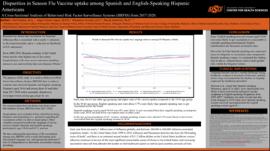| dc.contributor.author | Perkins, Del | |
| dc.contributor.author | Giron Lopez, Angel | |
| dc.contributor.author | Greiner, Benjamin | |
| dc.contributor.author | Hartwell, Micah | |
| dc.date.accessioned | 2023-09-12T16:45:07Z | |
| dc.date.available | 2023-09-12T16:45:07Z | |
| dc.date.issued | 2022-02-18 | |
| dc.identifier | ouhd_Perkins_disparitiesinseasonfluvaccine_2022 | |
| dc.identifier.citation | Perkins, D., Giron Lopez, A., Greiner, B., & Hartwell, M. (2022, February 18). Disparities in season flu vaccine uptake among Spanish and English-speaking Hispanic Americans: A cross-sectional analysis of Behavioral Risk Factor Surveillance Systems (BRFSS) from 2017-2020. Poster presented at Research Days at Oklahoma State University Center for Health Sciences, Tulsa, Ok. | |
| dc.identifier.uri | https://hdl.handle.net/11244/339543 | |
| dc.description.abstract | Introduction: Research has shown that vaccination for Seasonal Influenza (flu) is associated with a nearly ⅓ reduction in flu-related mortality and a ¼ reduction in likelihood of ICU admission.1 From 2009-2019, Hispanic residents of the United States had the third highest rate of flu-related hospitalization with more severe outcomes including intensive care and mortality than non-Hispanic Whites.2 Thus, the purpose of this study is to analyze Behavioral Risk Factor Surveillance System (BRFSS) data in order to compare rates between Spanish- and English-speaking Hispanics aged 18-64 and among those 65 and older from 2017-2020 with a secondary objective to investigate trends among age groups by sex. | |
| dc.description.abstract | Methods: For this cross-sectional study we extracted data from the Behavioral Risk Factor Surveillance System (BRFSS) from 2017-2020. The BRFSS uses raking weights to produce population estimates that adjust for survey non-coverage, non-response, and the probability of being sampled given geographic location, age, race, and sex.9 Respondents were included if they identified as being Hispanic and responding to a question regarding flu vaccination (either via shot or nasal spray). Other variables extracted included the language of survey used (to identify Spanish and English speaking participants), age (18-64 and 65+), and sex. We then estimated the prevalence of flu vaccination among easy BRFSS cycle overall and among each sub-group (language, sex, and age-group) and used X2 tests of independence to determine associations among groupings. | |
| dc.description.abstract | Results: Trends of the data showed that flu vaccine uptake among all Hispanics was lowest in 2018 (25.29%) while 2020 was the highest (34.83%). Each year, the 65 and older age grouping had higher rates of flu vaccine uptake compared to the 18-64 age group. Significant differences among English- and Spanish-speaking groups occurred each year, most often occurring among the 18-64+ group of both sexes. Hispanic US adults ages 65 and over had the highest percentage of flu shots received in 2017 (57.75%) while 2018 had the lowest (50.11%). Spanish-speaking men, age 18-64, had the lowest uptake of flu vaccination throughout the time span. | |
| dc.description.abstract | Conclusion: From 2018 through 2020 there was a statistically significant difference in uptake of English speaking women when compared to Spanish speaking women ages 18-64. Predominantly English speaking women aged 18-64 had higher vaccination rates in 2019 and 2020 while Spanish speaking women had higher rates in 2017. Pearson et al., found that Spanish-speaking Hispanics, aged 65 or older, were significantly less likely to have received the influenza vaccine compared to English-speaking Hispanices from 2005-2007.3 Our study reveals that this trend changed in 2018 when more Spanish speaking women received vaccination than the English speaking women aged 65+. Spanish speaking men aged 18-64 were also less likely to receive vaccination than Spanish speaking women aged 18-64 across the board when comparing statistically significant data. | |
| dc.format | application/pdf | |
| dc.language | en_US | |
| dc.publisher | Oklahoma State University Center for Health Sciences | |
| dc.rights | The author(s) retain the copyright or have the right to deposit the item giving the Oklahoma State University Library a limited, non-exclusive right to share this material in its institutional repository. Contact Digital Resources and Discovery Services at lib-dls@okstate.edu or 405-744-9161 for the permission policy on the use, reproduction or distribution of this material. | |
| dc.title | Disparities in season flu vaccine uptake among Spanish and English-speaking Hispanic Americans: a cross-sectional analysis of Behavioral Risk Factor Surveillance Systems (BRFSS) from 2017-2020 | |
| osu.filename | ouhd_Perkins_disparitiesinseasonfluvaccine_2022.pdf | |
| dc.type.genre | Presentation | |
| dc.type.material | Text | |
| dc.subject.keywords | influenza | |
| dc.subject.keywords | vaccines | |
| dc.subject.keywords | Hispanic Americans | |
| dc.subject.keywords | disparity | |
